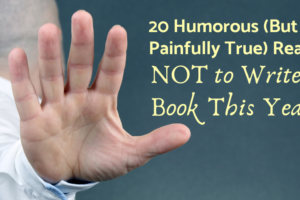8 Must Do Tasks to Complete BEFORE You Launch Your Book
In the olden days of the 20th century, books were launched or released by publishers who owned the “rights” (licensed from the author) and had a vested interest in seeing the book succeed. Indie publishing has not been invented yet. Yes, there was self-publishing, but that’s not the same thing. Go to this blog post to learn more about Indie, Hybrid, and Traditional publishing.
[note for reference: rarely does a traditional publisher “own” the copyright; it’s shown as being in the author’s name, but the publisher has licensed via the contract with the author every bit of the rights they can to sell, distribute, etc., that come with copyright]
Today, you become the person in charge of managing your book launch when you choose Indie publishing. You are the publisher. You own the copyright.
Here are 8 Must Do Tasks I think you should complete BEFORE you launch.
1. Develop a Premarketing Plan
- You will have already defined Your Target Audience if you work with us, but understanding them is a different animal:
- As you write, be active online connecting with members of your reading audience.
- Ask them questions. Answer their questions. Be sociable. Get to know them. If you can connect with a small group and get to know them by name, that’s golden.
- Build an Author Platform:
- Create or update your author’s website. Include a blog, an email newsletter sign-up, and information about your upcoming book. Ask for opinions on the title and cover design.
- Add new content frequently. This means writing in the blog at least 3 times a month. Share video and images – of you writing your book, of a story in Chapter 2, put yourself and the book out there in front of your people.
- Create a Book Launch Timeline:
- Plan your marketing activities leading up to the release date. This includes cover reveals, teaser content, and pre-order announcements. And asking for feedback about the cover, title, or subtitle.
- Create your book blurb. You may refine it and change it as you write the book, but if you can describe the book in 20 -25 words (or less) you will attract more eyeballs. Don’t write six dense paragraphs. No one will read them.
2. Leverage Social Media
- Engage Early and Often:
- Social media is your friend. Connect on Instagram, Facebook, LinkedIn, and TikTok. These are the places book people hang out. Get to know the clubs and groups associated with these platforms. Engage!
- Social media is your friend. Connect on Instagram, Facebook, LinkedIn, and TikTok. These are the places book people hang out. Get to know the clubs and groups associated with these platforms. Engage!
- Create Shareable Content:
- Post quotes from your book, behind-the-scenes looks, and cover reveals on your social channels and link to your website, your book page, Amazon, wherever you like. But have a reason to send people there and a way to track it.
- Make videos talking about your writing experience. Talk about why you wrote the book. Tell a secret story that is not in the book. Give people a reason to follow you.
- Utilize Hashtags and Communities:
- Create your hashtags well ahead of your launch.
- Look online for blogger book tours. We work with Kelly Lacey of Love Books Tours. Check her out and get on her calendar. Her book tours fill up fast! Read my blog post about how to find bloggers for your own book tour.
- Ask for beta readers among your online contacts. Beta readers are the start of your fan club.
- Create a spreadsheet to keep track of your beta readers. Email them at least once a week.

3. Build an Email List
- Offer Incentives:
- In our How to Market Your Book Like a Rock Star: The Taylor Swift Model of Book Marketing, we say: “Taylor Swift offers her Swifties prizes (gamify your book if you can), she thanks her fans in videos posted online, she shares inside, behind the scenes looks at her life and her travels. You can do this, too. Your incentive might be an eBook outlining how to do what you talk about in Chapter Four. Or it might be a workbook that will accompany the print book. Have a drawing once a week to see who wins the workbook and a copy of the print book, signed, for free!
- Regular Updates:
- Keep your subscribers informed with regular updates about your book’s progress, launch details, and special offers.
4. Connect with Influencers and Key Bloggers
- Identify Key Influencers:
- Find bloggers, reviewers, and influencers in your genre. Building relationships with them can lead to valuable endorsements and reviews. Review their stuff!
- Search Google for “gift guides” and add your genre. Many bloggers do gift guides throughout the year. Your book could be included in their package if you write and ask.
- Send Advance Reader or Review Copies (ARCs):
- Don’t be so worried about the ARCs or Beta copies. Sometimes, authors want the manuscript sent to Beta readers to be perfect. It’s supposed to be an uncorrected galley. Not a finished product. That’s why it goes out in advance of publication.
- Don’t just look for Beta readers among your closest friends or colleagues. Ask people you don’t personally know but who you are connected to on social media if they will join your Beta reader list.
5. Create your LLC and Imprint
- Your book is part of your business now:
- Ensure you’ve created the business entity that will be your ‘publisher.’ Make a logo design to serve that business entity. This will be your imprint.
- Your imprint goes on the cover and identifies the publisher of the book. This is why you need a pleasing design. Though readers don’t worry about who published a book before they buy it, they do look it over, and you want your imprint to look professional. Readers want quality work, and you will deliver that if you work with professionals like Master Book Builders.
- If you do not have a business, maybe your book is the start of a business, which means creating an LLC (Limited Liability Company) is imperative. Your LLC provides protection for personal assets. Check your state’s requirements to do this. But do it before the book is published!
- Design a Compelling Cover:
- The cover may mimic your business brand colors and design.
- Or it may be completely different. You must recognize that being a published author means visibility (if you’ve done your marketing correctly). Choose to stay with your business brand on your cover – or create something totally different and intriguing. There is no reason you can’t have a book that separates itself from your business but know that the book becomes a brand also. And then, so do you.
- Make sure your design works on “the world’s largest bookstore.” At least the main title and the imagery must be legible and should stand out among a row or page full of small thumbnails. We tell our clients their cover design needs to work both at 6×9 inches and at 60 x 90 pixels.
- Buy Your ISBN:
- You will need an ISBN. That’s the International Standard Book Number. This allows you to sell your book in bookstores. If your book is a series, you need one for each book. If you are creating an eBook and audio with the print book, each one gets its own ISBN.
- You purchase your ISBN from Bowker (in the US). We have a step-by-step handout we give our authors describing how to fill out the forms and why having this is necessary.
- I also need to tell you that both the ASIN and the “free” ISBNs you can get from Amazon if you use KDP to create and publish your book and/or eBook will belong to Amazon. You cannot use it to sell your book in bookstores or on other online platforms. Once again, buy your own ISBNs. Get a block of 10 ISBNs from Bowker (they’re cheaper that way) for use with your print book(s), eBook(s), audiobook, companion workbook, and 10th Anniversary Update Edition!
6. Become a Sought-after Speaker
- Podcasts:
- Get on podcasts and talk about your book’s message. Start honing your throughline message early on, and you’ll be golden by the time the book is released.
- Make sure to create a speaker one sheet. This introduces you and your subject matter for your podcast hosts to review before you are on their show.
- Keep a spreadsheet of all podcast shows you are on.
- Speak locally at networking groups:
- Your local Chamber of Commerce likely has speakers at meetings. Explore how you can present there.
- Women’s groups are always looking for good speakers. Make sure you have the right hook to join and speak at one of these groups.
- Business events and conferences.
- Find out where your book’s topic will fit and submit your application to speak.
- Create a presentation you can use repeatedly. Personalize it for the group you’re presenting to but try not to recreate what you already have. Repurpose what’s already on your computer.
7. Look Beyond Copyright
- Trademarking:
- If your tagline or logo or business name is attached to your book, you might think of trademark protection.
- According to Michael E. Kondoudis: “Trademarking your name, your logo, a phrase (slogan), and hashtag gives you the exclusive right to use them. If you don’t, then your competition can use them. Only one business can own a brand in an industry. Typically, it’s whoever trademarks it first.”
- Since you cannot copyright a title – the next best thing is to trademark your hashtags or logo or business name. But don’t go it alone. Hire a professional like our friend, Shahrina Ankhi-Krol who is the best IP lawyer we know.
8. Make Friends with Independent Bookstores
- In my blog post titled, Why it’s so hard to sell that great book you just wrote. Or is it? I talk about independent bookstores. It’s worth a read to learn more about Independent bookstores and why you should make friends with them before your book is done.
- Create an event for your local bookstore (this could work at B&N too). Invite people to a book signing and ask the store if you can do it there. They’ll love the extra visitors.
- Put your book in front of bookstore owners at events they would attend. Search “conferences and events publishers attend” and you’ll find a wealth of information on conferences you can add your book to. It’s about being seen!
All of this is to say that you, the author, must be in charge of these tasks. You are the one taking on the role of sales and marketing for your book. If you do these tasks beforehand, you will see more and better results afterward.






1 Comment
Leave your reply.